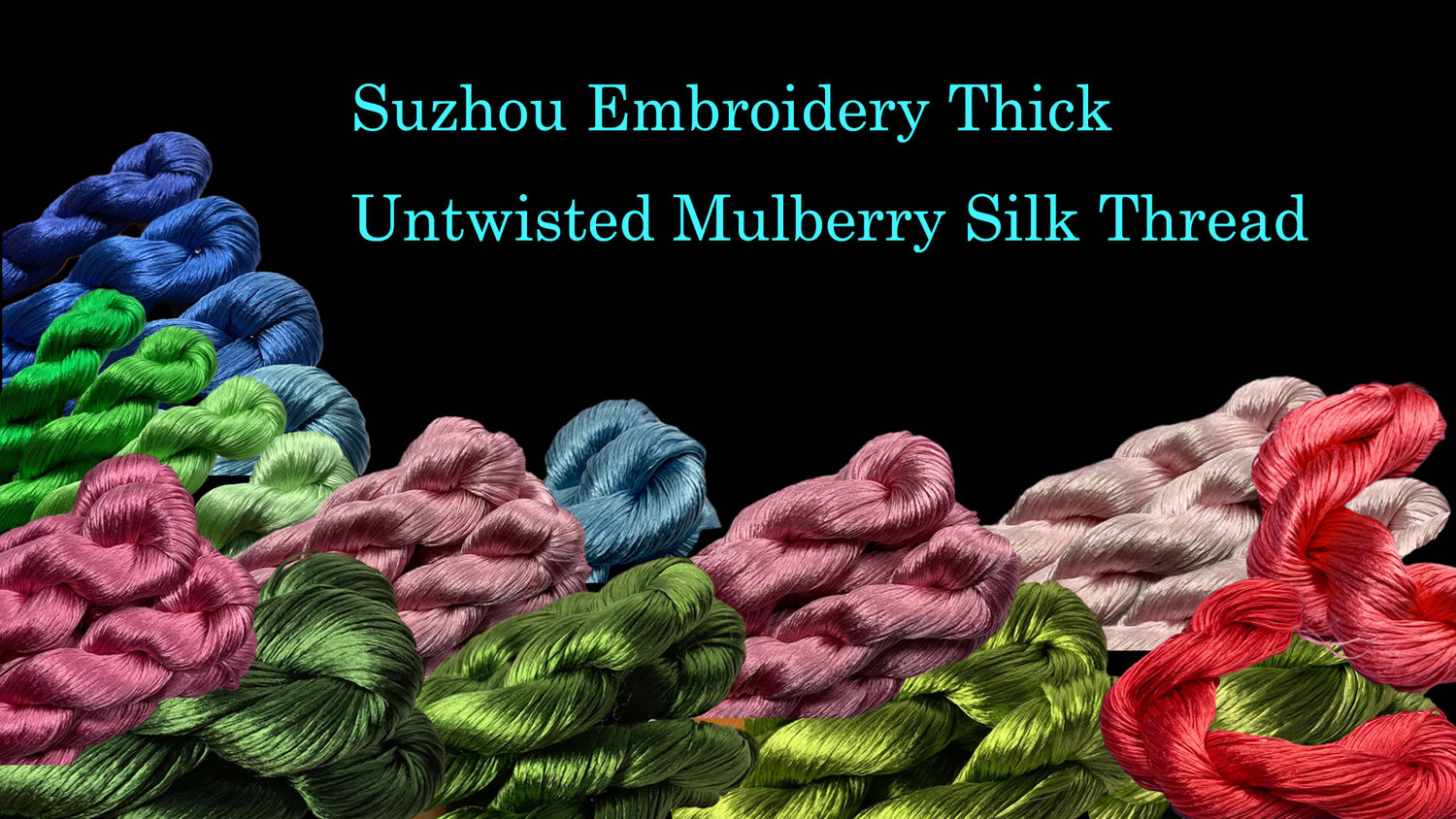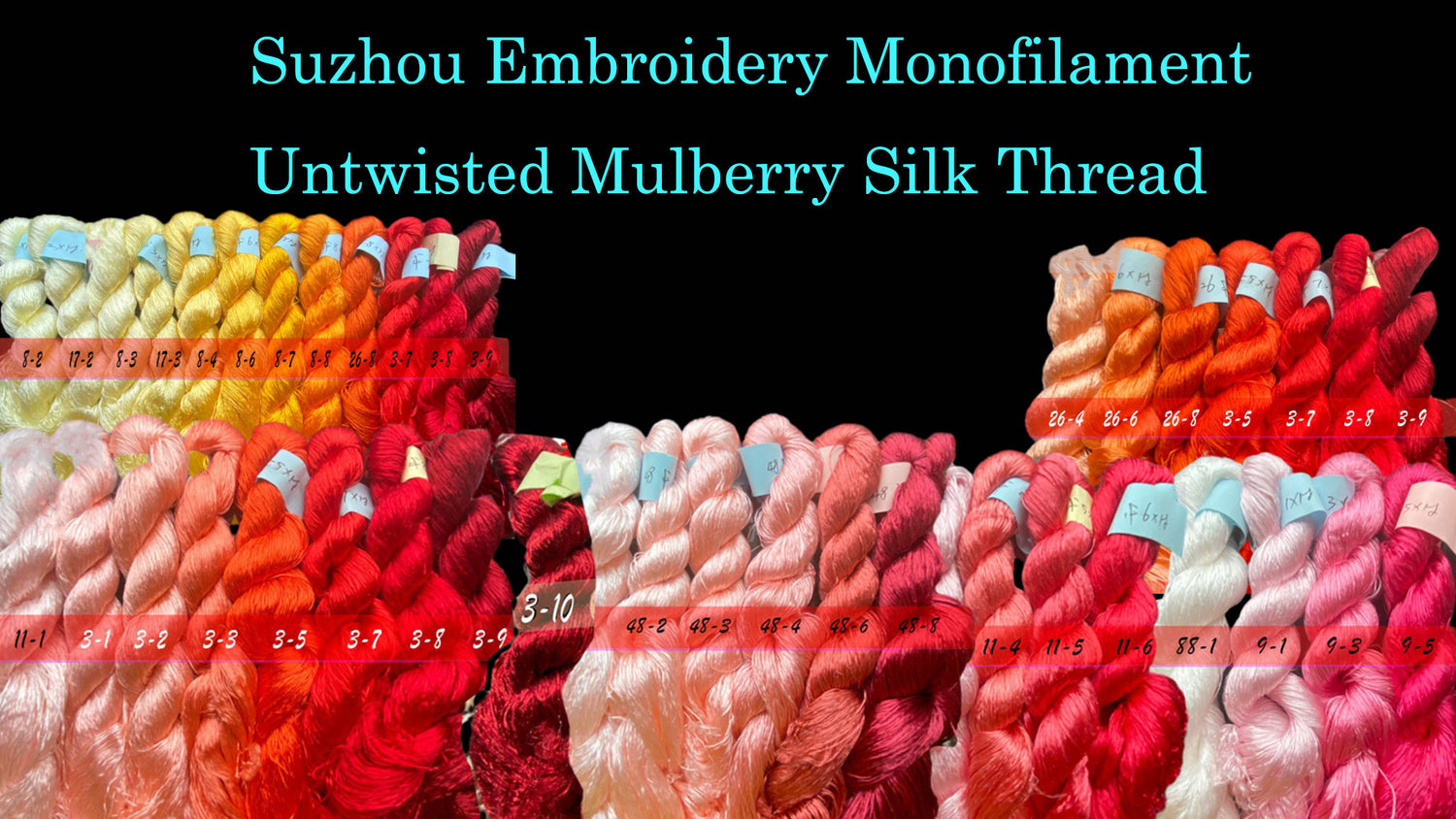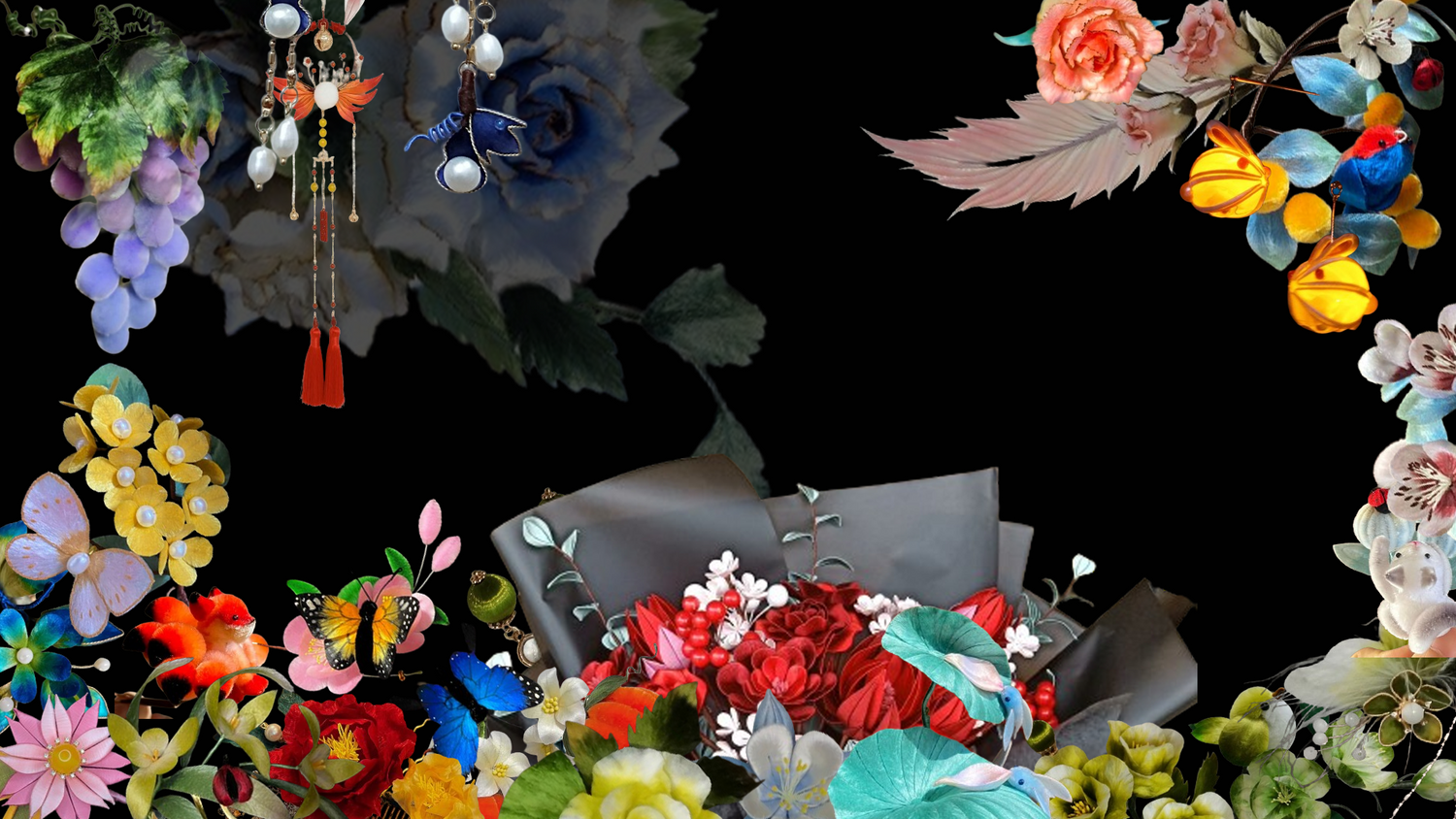
The Process of Making Ronghua - Handcraft Ronghua Tutorial
Share
To make a complete Ronghua, the process includes several steps: tying the silk, combing the silk, fixing the velvet strip, tying the velvet, cutting the velvet, twisting the velvet, trimming the velvet, and shaping.
A. Tying the Silk
Tying the silk is the process of securing the silk threads onto a stick, which is a crucial and important step in making Ronghua.
 Tying the Silk- Solid Color Effect
Tying the Silk- Solid Color Effect
Cut a bundle of silk threads from the joint, take out 6 threads as a group, fold them in half, and secure them on the stick.
 Tying the Threads - Gradient Color Effect
Tying the Threads - Gradient Color Effect
To achieve a gradient color effect, use two or more colors of threads when tying. Gradually reduce the number of threads of the first color and increase the number of threads of the second color at the color transition point, combining them into a group. Note that you can intersperse threads of various shades during the color transition. Below is the process for tying a gradient from white to red. Each group has 6 threads: the first group has 6 white threads, the second has 4 white and 2 red threads, the third has 3 white and 3 red threads, the fourth has 2 white and 4 red threads, and the fifth has 6 red threads.
 Gradient Color Tying Demonstration
Gradient Color Tying Demonstration
This is the method for tying the threads for a gradient-colored lotus petal. The main color of the lotus petal is pink, which occupies more than half. The pink in the middle gradually transitions to the ends, with the color changing from the middle to the ends in this sequence: pink - light pink - white - light yellow.
 Gradient Color Tying Techniques Demonstration
Gradient Color Tying Techniques Demonstration
When making flat gradient-colored butterfly wings, since only one end of the velvet strip needs to be trimmed, you can use the mirror principle. Create a symmetrical arrangement of silk threads on the right side of the velvet strip, then cut the strip in the middle to get two strips with the same color. This greatly improves the efficiency of tying the silk.
 Tip: Splitting the Silk
Tip: Splitting the Silk
If using Suzhou embroidery threads or Hunan embroidery threads, split the threads by gently twisting them in the opposite direction and then pulling out one strand, smoothing out both strands.
B. Combing the Silk
Combing the Silk involves using a tool to comb the silk threads, making them fluffy.
 1
1
- 1. Firmly secure the tied silk threads, then use your hands to smooth them out into a velvet row. Divide the velvet strip into small sections and prepare for combing.
 Tip: Trimming the Thread Ends
Tip: Trimming the Thread Ends
- Tip: Trimming the Thread Ends: Use your left index and middle fingers to pinch the threads tightly, then pull them taut and trim the bottom ends of the silk threads neatly.
 2
2- 2. Start combing from the bottom of the velvet row with a brush. Keep the silk threads taut throughout the combing process until each thread becomes fluffy without any obvious strands.
 3
3- 3. If there are unsplit threads during the combing process, separate them and repeat step 2 until the threads are completely fluffy.
C. Fixing the Velvet Row
Fixing the velvet row is important for the subsequent steps of tying the silk and twisting the silk, ensuring that the final velvet strips have a good effect.
 Fixing the Velvet Row
Fixing the Velvet Row
Gather and pull the combed velvet strip taut (for narrow strips, this can be done all at once; for wider strips, do it in sections). Brush from top to bottom to smooth the strip, then fix the end of the velvet row to the table with a clip, making sure to keep the strip taut.
 Tip
Tip
Tip: Fixing the Velvet Strip: If using a wooden stick to fix the velvet row, clamp the middle of the taut strip with the stick and slide it to the bottom end. Secure both ends of the stick with rubber bands to hold the strip firmly. If there is static electricity or the strip bends during combing, straighten the strip with one hand and lightly spray it with water from a spray bottle (the kind that produces a fine mist). Be careful not to spray too much water; three or four sprays are enough. The water should be dry by the time the brass wire is tied. Wipe off any small water droplets from the strip with your hand or brush before fixing the strip.
D. Tying the Velvet
When tying the velvet, ensure that each velvet strip has the same width and spacing; otherwise, the resulting velvet strips will vary significantly.
 1
1
- 1. Take out the annealed brass wire and apply a little anti-slip powder to your fingers. Align two brass wires and twist one end a few times to secure them. Continue to apply anti-slip powder to your fingers to increase friction while twisting.

- 2. Pinch the brass wires at the desired length with both hands and twist a few times to secure them, then smooth out the remaining portion of the brass wires by hand.
 3
3- 3. Use the end of the brass wire with a larger opening to clip the velvet row. Hold the other end of the brass wire and adjust its position so that the velvet row is in the middle of the brass wire.

- 4. Cross and lightly twist the two ends of the brass wire on the right side of the velvet row to make a start. Then, secure the twisted brass wire on the left side of the velvet row and twist the brass wire from the starting point on the right side inward with both hands, securing the brass wire on both sides of the velvet row.

- 5. After securing the brass wire to the velvet row, slide the brass wire down to the appropriate position. Fix multiple groups of brass wires on the velvet row using the same method.
E. Cutting the Velvet
Cutting the velvet means cutting the velvet strips from the velvet row. Note that the scissors should be parallel to the brass wire and cut between two groups of brass wires.
 1 2
1 2
- 1. Remove the clips fixing the velvet row and use long scissors to cut off the excess silk threads at the bottom of the velvet row.
- 2. Dip the index and middle fingers of your left hand in a little anti-slip powder, then gently lift the velvet row with your hand and lay it flat on your index finger. Use scissors to cut the velvet strip in the middle between the two groups of brass wires securing the velvet row.
- Tip: Cutting Velvet Techniques: Cut the velvet quickly, accurately, and steadily. The scissors used must be sharp. If you cannot cut the velvet strip in one go, the silk threads secured by the brass wire will move due to repeated operations.
- 3. After cutting the velvet strips, pinch the ends of the brass wires with both hands and pull them taut. Align the silk threads on the velvet strip using a flat surface, with the middle line being the central brass wire. Then lightly twist both hands in opposite directions.
F. Twisting the Velvet Strip
Twisting the velvet strip involves using two wooden boards (twisting boards) to rub the brass wire back and forth, twisting it into a spiral shape and securely clamping the silk threads, thus forming the basic velvet strip component for making Ronghua.
 Twisting the velvet strip
Twisting the velvet strip
Place one end of the brass wire of the velvet strip on one twisting board, then rub the other twisting board along the direction of the twisted brass wire, making the velvet strip fluffy. Use tweezers to gently separate the uncurled silk threads, completing a basic velvet strip component.
 1.The freshly cut velvet strip
1.The freshly cut velvet strip
2.The shape after initial fixation
3.The shape after twisting the velvet strip
The picture shown above is the transformation of a velvet strip from being cut from the velvet strip to becoming a usable velvet strip.
G. Trimming the Velvet
Trimming the velvet involves using scissors to trim the velvet strip, shaping the cylindrical velvet strip into various desired shapes.
 Trimming the velvet
Trimming the velvet
When trimming the velvet, hold the velvet strip in your left hand and the scissors in your right hand, tilting the tips of the scissors close to the top of the velvet strip. Rotate the velvet strip with your left hand while trimming with the scissors. After trimming both ends of the velvet strip, use tweezers to remove any excess fluff, completing the trimmed velvet strip. Note, avoid significant hand movements while trimming to ensure the velvet strip remains aesthetically pleasing.
H. Shaping
Shaping the velvet strips generally involves designing the appearance based on the needs of the finished Ronghua using tweezers to form the trimmed velvet strips.
 Shaping the velvet strips
Shaping the velvet strips
Depending on the desired shape (e.g., flower shape), fold and cross the trimmed velvet strip from the brass wire to form petals.
I. Assembling the Flower
Assembling the flower involves combining the shaped velvet strips with various decorative accessories to create the desired effect.
 1
1
- 1. Prepare silk threads, a suitable amount of plaster stamens, and velvet strips shaped into petals. Five identical velvet strips are needed for this flower.

- 2. Cut the plaster stamens in half and combine them, then tie them securely with silk thread. After securing, trim the bottom end of the plaster stamens at an angle.

- 3. Take a velvet strip and bend the brass wire at the bottom with tweezers to bind it with the plaster stamens. Repeat this process to bind the plaster stamens and the remaining four velvet strips, assembling them into a small Ronghua. Note, tie each petal individually to adjust their positions.
 4
4- 4. Adjust the shape of the velvet flower petals with tweezers. This completes the velvet flower.







